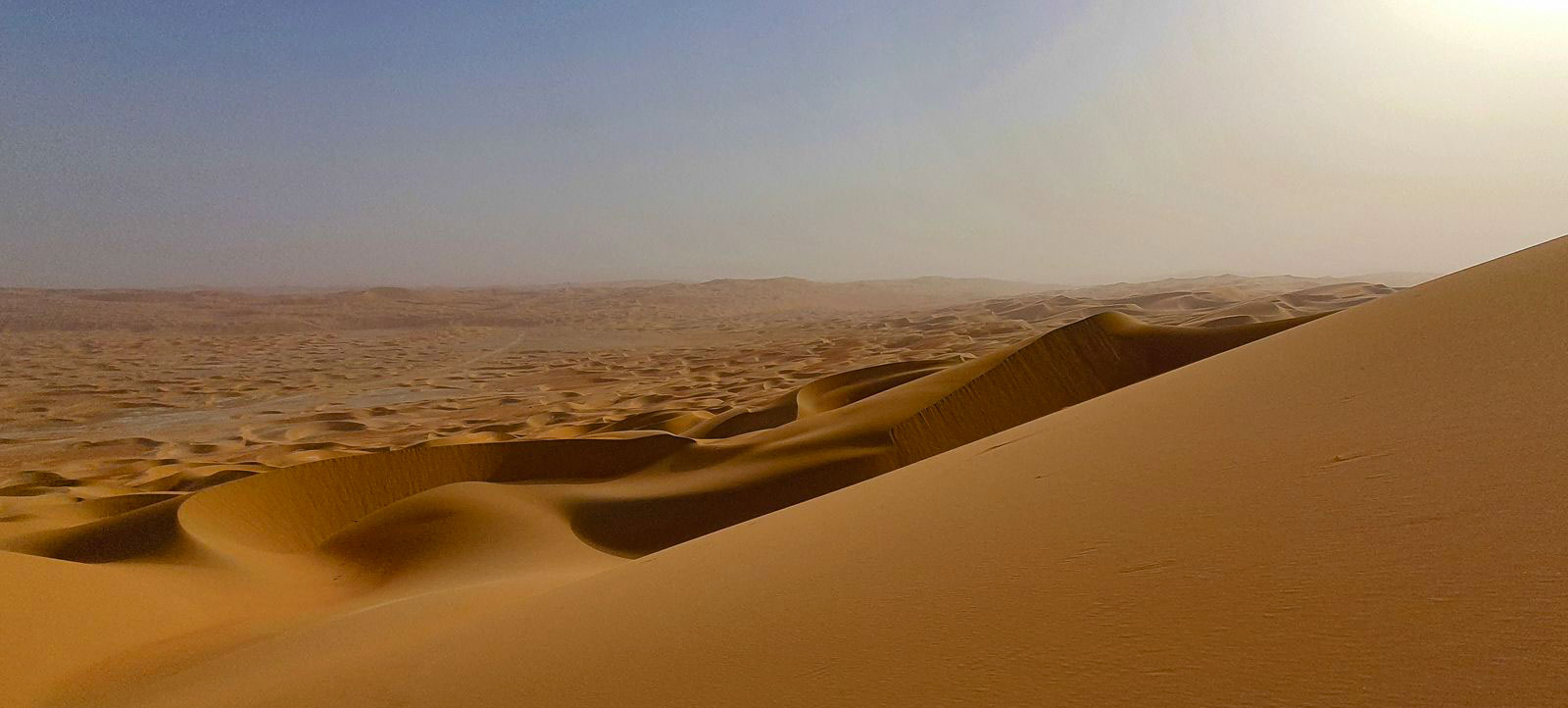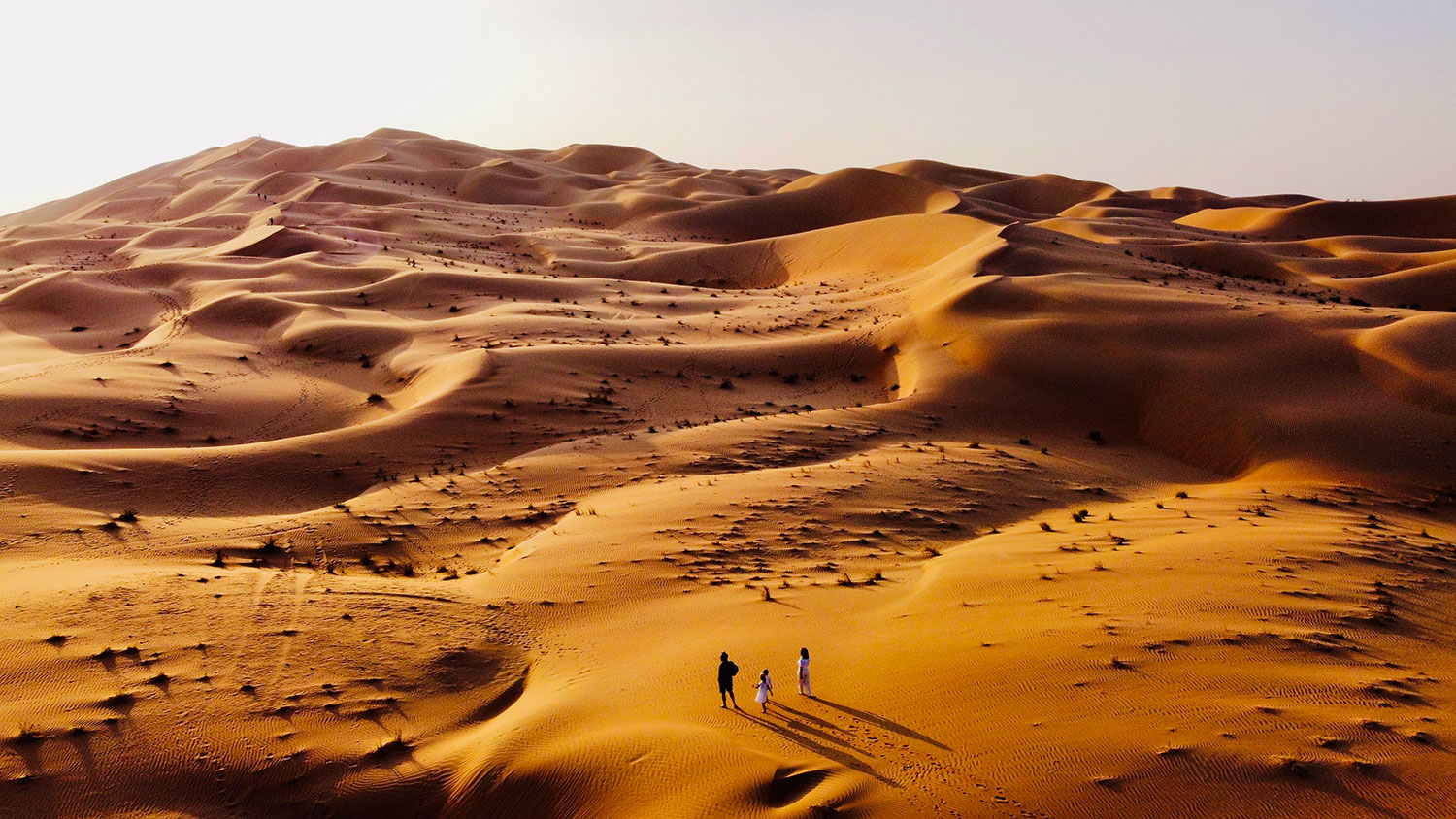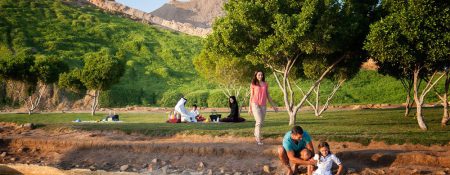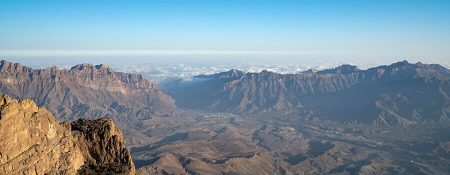Located in the far western part of the country, near the border with Saudi Arabia, Liwa is a natural gateway to the Rub’ al Khali, or “The Empty Quarter” – the largest contiguous sand desert in the world. Known for its high-rise pristine golden sand dunes and rich history, Liwa captures imagination with its majestic beauty, sense of isolation and historical significance. It is a place where the past and present meet, drawing tourists, adventurers, and filmmakers alike to its mesmerizing terrain.
Historically, Liwa holds a vital place in the history of Emirates. Originally, the nearby Liwa Oasis was an ancestral home of the Bani Yas tribe, whose descendants would eventually establish such cities, as Abu Dhabi, Al Ain and Dubai. For centuries, the nomadic Bedouins of Liwa were living in the harsh desert environment, relying on date farming and raising camels. The region’s settlements served as vital stops for traders and travelers moving through the desert, and today, you can still find clusters of date palm groves that stand as living reminders of Liwa’s role as an agricultural and cultural hub. The Liwa Forts, some of which have been restored, also hint at the area’s importance as a defensive frontier in the past, guarding against invaders and controlling trade routes.

The mesmerizing beauty of Liwa’s dunes is truly unique, unlike any other desert of the world. Sands of Liwa are known to be shifting in color from deep orange to shimmering gold, depending on the time of day, creating a constantly changing landscape. Towering dunes, some of the highest in the world, can reach heights of over 300 meters, including the famous Moreeb Dune, often called the “Terrifying Mountain” due to its immense size. Adventurous travelers from around the world come to Liwa for dune bashing, sandboarding, quad biking and other active sports, while others simply desire to witness the sublime beauty of the deep desert, especially at sunrise or sunset when the play of light creates a surreal, almost otherworldly atmosphere.
Despite its seemingly barren appearance, the Liwa Desert is home to a surprising amount of flora and fauna, and a multilayered, complex ecosystem. Hardy desert plants such as ghaf trees, acacia, and wild grasses dot the landscape, thriving in areas where groundwater seeps close to the surface. After rare rains, the desert bursts into life with small flowering plants, turning the sand into a colorful tapestry. Wildlife in Liwa includes desert foxes, Arabian oryx, and camels, alongside a variety of reptiles and birds that have adapted to the extreme conditions. The Arabian oryx, once nearly extinct, has been successfully reintroduced into the desert and now roams freely in parts of the region. Birdwatchers can also spot species such as larks, kestrels, and desert wheatears.
In recent years, Liwa has gained an international recognition as a favored location for multiple well-known blockbuster Hollywood films. Its vast emptiness, beauty and sheer scale of its dunes create a perfect cinematic image that has captivated filmmakers and audiences alike. The desert’s dramatic, otherworldly landscapes have served as the perfect backdrop for many science fiction and epic adventure movies. The vast dunes were used in “Star Wars: The Force Awakens”, where Liwa stood in for the desert planet Jakku, evoking the sense of a distant, alien world. More recently (in 2021 and 2022), the sweeping dunes were featured in the highly anticipated “Dune” and “Dune: Part Two” adaptations, where Liwa became the desert planet of Arrakis, the film’s iconic setting.

Liwa’s rich cultural history, combined with its surreal landscapes, has made it a popular destination for both Emirati citizens and tourists. Each year, the Liwa Date Festival celebrates region’s long-standing tradition of date farming, offering a fascinating insight into the agricultural heritage of the desert. The festival attracts farmers from across the UAE, competing to showcase the best varieties of dates, while visitors can sample traditional Emirati cuisine and enjoy cultural performances. Another highlight is the Liwa International Festival, which is held near the towering Moreeb Dune and features motorsport competitions, including dune climbing, 4×4 racing, and motocross, making it a hotspot for adrenaline junkies.
Liwa’s appeal lies not only in its status as a film set or its historical importance but also in its ability to offer a profound sense of peace and isolation. Visitors who camp under its starry skies often speak of the tranquility and awe they experience in the desert’s stillness. The night sky, far from the city lights, offers some of the best stargazing in the region, with clear views of constellations and the Milky Way. For many, a trip to Liwa is not just an adventure but a spiritual retreat, a chance to connect with nature in one of the world’s most extraordinary desert landscapes.
For visitors looking for high adrenaline desert experiences, activities such as dune bashing, off road driving, and dune buggy Dubai tours are among the most popular choices for adventure seekers exploring the UAE.
In conclusion, the Liwa Desert is a place where nature, history, and culture converge in a most extraordinary way. Its towering dunes, rich heritage, and thriving ecosystem offer an unparalleled experience for those who seek to understand the deep connections between the people of the UAE and the desert. Whether you’re a thrill-seeker looking for adrenaline-pumping activities, a filmmaker in search of a striking location, or a traveler yearning for solitude and reflection, Liwa promises an unforgettable journey into the heart of the Arabian desert.




The UAE’s rich history is rooted in trade and tied to Islam. Its unique location between Europe and the Far East became the crucial factor in it's growth into the world's largest trading hubs. Throughout the ages, these lands had attracted merchants from India and China, and were prized by Europeans, in particular the Portuguese, the Dutch and the British.
After the discovery of oil and the formation of the Emirates, the wise rulers began the rapid development of the country's economy, shaping it into what it is today. Though small in size, the UAE quickly became an important player in regional and international affairs.
Although it's growth and development, UAE heritage have not been forgotten - on the contrary, is still well-respected among the nationals. History and culture of local people can be felt in the legendary hospitality of local hotels, architecture of modern skyscrapers and openness and kindness in living among the multinational community.
Here you can read various articles about UAE heritage, history and culture, and better understand, why this country's development became such a success throughout the years.